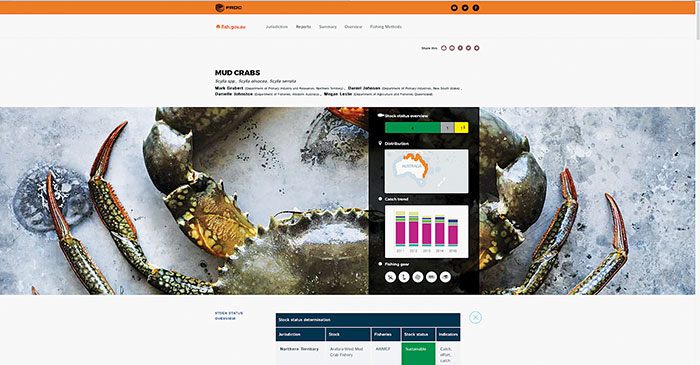A new approach to reporting the status of Australian fish stocks improves transparency and provides public access to dynamic data on the status of stocks
 The SAFS reports are available online at a new website, www.fish.gov.au. The website provides species specific information.
The SAFS reports are available online at a new website, www.fish.gov.au. The website provides species specific information.By Peter Horvart
The future of Australia’s fishing sector depends on healthy aquatic habitats, environments and fisheries. To ensure the aquatic ecosystems continue to produce seafood for the present and future, Australia needs a scientifically rigorous independent assessment of fished stocks.
The latest edition of the Status of Australian Fish Stocks (SAFS) Reports, released in December 2016, shows Australia’s fish stocks are in good shape, with almost 60 per cent of included stocks assessed as sustainable.
Among the best-performing stocks, in terms of sustainability, are prawns, which also have the highest number of Marine Stewardship Council certified fisheries.
The 83 species and species complexes assessed represent approximately 90 per cent of both the volume and value of Australia’s total fisheries production and include 294 individual fish stocks.
This third edition of the reports has added 15 new species, including iconic species such as the Western Australian Dhufish and the popular Orange Roughy, which have both endured severe population declines. The FRDC coordinated the production of the reports in 2016, for the first time, and plans to expand the species reported on to 200 by 2020.
FRDC executive director Patrick Hone says the reports provide a simple way for seafood consumers, fishers, managers and the public to understand how Australia’s fish stocks are performing. The reports bring together the best available information to determine the status of Australia’s wild fish stocks against a national reporting framework that provides transparency and consistency across all jurisdictions.
Almost 100 of Australia’s fisheries scientists were tasked with producing the 83 species reports. In addition, a further 50 fisheries scientists anonymously reviewed the reports to ensure they are as accurate as possible. “A scientifically rigorous approach to the stock status assessment and the reporting process is crucial,” Patrick Hone says. The reports could not have been produced without the significant assistance of the fisheries science community and the dedication of the FRDC team.
| Number of stocks | ||||||
|---|---|---|---|---|---|---|
| Stock status | Biological stock | Management unit | Jurisdiction | Total Stocks | Catch ("000 t) |
% of catch species |
| Sustainable stock | 85 | 56 | 34 | 175 | 114.84 | 85.41 |
| Transitional-depleting | 7 | 15 | 4 | 26 | 3.91 | 2.90 |
| Transitional-recovering | 5 | 4 | 9 | 1.29 | 0.96 | |
| Overfished | 6 | 7 | 3 | 17 | 8.51 | 6.33 |
| Environmentally limited | 4 | 1 | 5 | 0.03 | 0.02 | |
| Undefined | 12 | 17 | 20 | 49 | 5.87 | 4.36 |
| Negligible | 2 | 2 | 9 | 13 | 0.01 | 0.01 |
| Total | 118 | 105 | 71 | 294 | 134.45 | 100 |
Findings
The reports highlight the dynamic nature of fisheries and reinforce the need for constant monitoring and management. Managers and fishers alike cannot rest on their laurels. The reports highlight two key categories that should remain the focus for both – ‘transitional depleting’ and ‘overfished’
The number of stocks in both categories has increased – partly due to the inclusion of the 15 new species – with 26 stocks, representing 14 species, reported as ‘transitional depleting’.
There were 17 ‘overfished’ fisheries, representing 13 species, which is of concern. Close monitoring of these stocks will continue as part of the recovery and management plans in place to restore their numbers.
All of the 49 stocks classified as ‘undefined’ also have management in place; however, there was insufficient data available to confidently classify the stocks. The 13 stocks classified as ‘negligible’ have a very small commercial catch.
The SAFS reports are available online at a new website, www.fish.gov.au. The website provides easy access to dive into this wealth of information.
New design
 Data can be interrogated by users on fish.gov.au.
Data can be interrogated by users on fish.gov.au.The design of the reports has undergone a significant makeover and expansion of online functionality. New photographs of species have been added to enhance the visual appeal of the website
Data has become the backbone of the website’s functionality. This, combined with new web technology, means readers can not only see the data, they can explore and interrogate it.
One advantage of putting this new design in place has been the ability to generate jurisdiction-based reports. The jurisdictional reports only show the species and stocks found in their waters. Going forward, the FRDC aims to ensure the new data structure will enable national data to be extracted for international data sets and assessments.
The future
The FRDC will further develop and expand the Status of Australian Fish Stocks Reports over the next year to encompass a more comprehensive and holistic view of Australian seafood sustainability. In addition to information on fish stocks, information on bycatch (non-target) species, fisheries management and impacts on aquatic habitat will be included.
The continuing development of the Status of Australian Fish Stocks Reports and the commitment to the highest level of scientific input and process means that Australians can be confident that locally caught seafood is being sourced from fisheries that are being managed for sustainability.
FRDC Research Code: 2014-041





